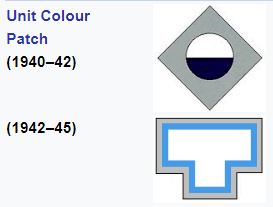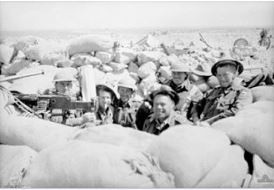2/48th Australian Infantry Battalion
From Our Contribution
 | |
 Members of the 2/48th Battalion manning a defensive position around Tobruk in 1941 | |
Contents
[hide]Brief History
The 2/48th Australian Infantry battalion was the most heavily decorated Australian unit of the war.
The 2/48th Battalion was raised on 9 August 1940 at the Wayville Showgrounds, in Adelaide and recruits came primarily from South Australia. With around 900 personnel, as for other Australian infantry battalions of the time, the battalion contained four rifle companies— 'A' through to 'D'—each consisting of three platoons. These companies were supported by a battalion headquarters and a headquarters company with six specialist platoons: signals, pioneer, anti-aircraft, transport, administrative and mortars. Part of the 26th Brigade along with the 2/23rd and 2/24th Battalions, it was assigned to the 7th Division during its initial training period but was later transferred to the 9th Division.
The battalion embarked in Port Adelaide upon SS Stratheden on 17 November 1940, and sailed the following day via Colombo, arriving at Suez. Disembarked they moved to camp at El Kantara before moving to Dimra in Palestine where they undertook further training with other elements of the 26th Brigade. In March 1941, with other elements of the 9th Division it moved to Cyrenaica where they relieved the 6th Division which had redeployed to Greece. After Rommel's German troops landed in North Africa the 2nd/48th participated in the withdrawal to and then defence of Tobruk. Relieved by British troops in October 1941, they had defied the Germans for 7 months with 160 casualties in that time, including 38 killed and 18 who died later from their wounds.
Next stop was Palestine followed by Syria where they rested and trained before being transported south to Egypt and west to El Alamein where they were committed to the battle to halt Rommel's advance. During this period the battalion suffered 64 KIA, 6 DOW, and 125 WIA. After a period of rest they rejoined the line at El Alamein where in fierce fighting they lost another 85KIA, 13 DOW and 243 WIA. They were again withdrawn from the line, this time just as Montgomery's troops broke through the German and Italian lines. The battalion then moved to Gaza on 3 Dec 1942, and as part of the decision to bring all troops home, they boarded the HMT Nieuw Amsterdam in Port Tewfik for Australia on 1 February, reaching Fremantle on 18 Feb 1943.
Following leave, the battalion moved to Atherton in North Queensland, converting to a tropical establishment as it no longer required an anti-aircraft or Bren carrier platoons. In July 1943 they undertook amphibious landing training at Cairns before sailing to New Guinea aboard the HMT Henry T. Allen, landing at Milne Bay. They were subsequently involved in the amphibious landing at Lae on 4 Sep 1943. The battalion participated in fighting at Finschhafen, Sattleberg, and Wareo before being relieved and sent back to Australia for a rest. New Guinea casualties were 36 KIA, 3 DOW, and 77 WIA as well as 8 who died of illness.
The battalion reformed at Ravenshoe on the Atherton Tableland in Apr 1944, with many new men taking the place of veterans who transferred out to other units. After more than a year's training they moved to Morotai Island, preparing and rehearsing their part in the landing on Tarakan which occurred on 1 May 1945, and heavy fighting continued until Jun 1945 when the mopping up phase commenced. Casualties in Borneo included 37 KIA, 9 who died from wounds or accident and 128 WIA. The battalion was disbanded on 25 Oct 1945 while still on Tarakan, and was the highest awarded unit in the 2nd AIF
The colours initially chosen for the battalion's Unit Colour Patch (UCP) were the same as those of the 48th Battalion, a unit which had served during the First World War before being raised as a Militia formation in 1921. These colours were white over dark blue, in a circle shape, although a diamond-shaped border of gray was added to the UCP to distinguish the battalion from its Militia counterpart; this was following the unit's involvement in the fighting at Tobruk, when it adopted a 'T'-shaped unit colour patch.
Battalion Personnel
- Ronald Gwynne 12 Sep 1941 - 1 Jan 1945
- Arthur Donald Free 5 Jul 1944 - 24 Oct 1945
Battle Honours
- Defence of Tobruk
- El Adem Road
- The Salient 1941
- Defence of Alamein Line
- Tel el Eisa
- El Alamein
- Defence of Scarlet Beach
- Finschhafen
- Sattelberg
- Borneo
- Tarakan
Individual Honours
- 4 x Victoria Cross
- 4 x Distinguished Service Order
- 11 x Military Cross
- 10 x Distinguished Conduct Medal
- 23 x Military medal
- 39 x Mentioned in Despatches
Notes
Content for the history and honours sections has come from a combination of Wikipedia and the Australian War Memorial websites.